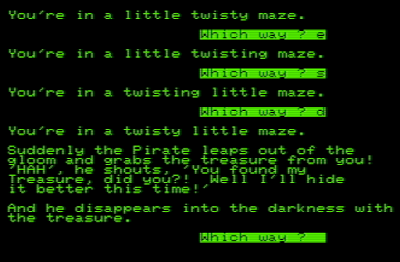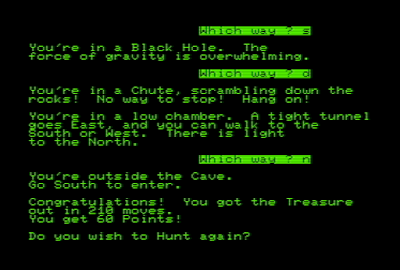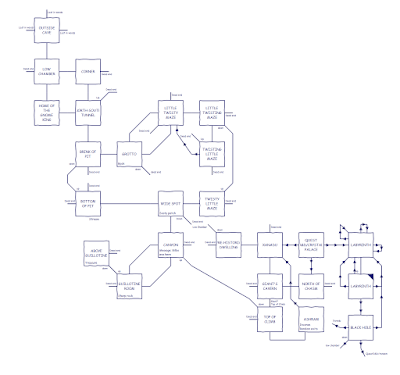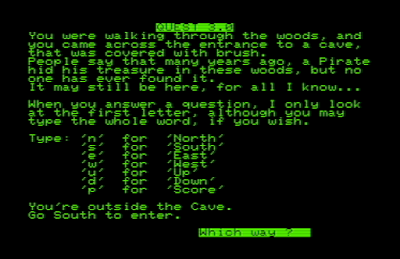From CRPG Adventures
Back in May I played a game called Treasure Hunt, and I was pretty sure that it was as basic as the adventure game genre could get. Well, step aside Treasure Hunt, because we have a new contender in Quest.
Quest was written by Roger Chaffee (who I think was a school teacher), who was inspired by Colossal Cave Adventure. He started the project when his school received a pair of Commodore PETs, and finished the game in a couple of weeks. The code was printed in the July 1978 issue of Byte Magazine, which is archived here. I’m playing version 3.0, using WinVice as a PET emulator.
The premise is dead simple: you stumble across a cave where it’s rumoured that a pirate his his treasure years ago. Like many an adventure game, your goal is to find the treasure and bring it back to the cave entrance.
The command list above is the entirety of what you can do in this game. You move around using the four cardinal directions, as well as up and down. I spent a good few minutes trying to type things in like it had a real parser before I realised just how simplistic this game is.
With nothing else to do but wander, I didn’t have to feel bad about my usual method of ignoring puzzles until I had mapped out a chunk of the game. It’s not all that large, and mapping only took me a little over an hour.
The two exits from the first cave lead through either a narrow tunnel, or the home of the Gnome-King (who is currently not home). There’s a maze of twisty passages, in which the rooms are thankfully distinguished by subtly different descriptions. A pit leads down to a canyon, which features the graffiti “Bilbo was here”. Past the canyon is a guillotine room, which is not as deadly as it sounds. (I’m not actually sure you can die in this game; I never managed it.)
Climbing up the canyon leads to the home of a Giant, who your character will automatically avoid if he shows up. Another path leads through an incense-filled room, and then to Xanadu, which is described as having “caverns measureless to man” in a reference to Samuel Taylor Coleridge’s poem Kublai Khan (see, have some culture). East of Xanadu is the Quest Control Center, which is probably a reference to the end-game of Colossal Cave Adventure, where you end up in a repository of the game’s various elements. When you enter the Control Center you’re immediately kicked back to Xanadu, so this was as much as I was able to map to begin with.
The treasure is found in room above the Guillotine Room, and the game simply prompts you with a yes/no question as to whether you want to take it. This is where Quest actually becomes an adventure game, because you can’t take the treasure back to the entrance: the Gnome-King will be there to block one path, and on the other the tunnel is too narrow to fit the treasure through. The goal is now to find an alternate path outside.
The first path I tried was through the maze, but I hadn’t gone far before a Pirate jumped out and reclaimed his booty. My first instinct was to go back to the treasure’s original location, to see what was there. It wasn’t the treasure, but there was a note saying that pirates never hide treasure in the same place twice. My second instinct, based on my memories of Colossal Cave Adventure, was to thoroughly explore the maze. Sure enough, I found the treasure in a dead end. I half-expected the pirate to show up again after I reclaimed it, but he never did.
 |
| I swear this is the exact dialogue from Colossal Cave Adventure. |
After bumbling around for a little while, I eventually went back up to Xanadu and tried the path through the Control Center. This time, presumably because I was carrying the treasure, the path led to a Crystal Palace, and then to a labyrinth. The labyrinth was dead simple, as it only has two rooms, and I was able to get through by heading south repeatedly. It ended at a Black Hole, and by heading down from there I entered a chute that dumped me near the cave entrance. One move north, and I was outside and victorious.
 |
| Beating the game. |
Originally Quest didn’t have a score, but Chaffee added one after the children who played it complained. You score 1 point for every location entered, as well as for things like meeting the pirate and escaping with the treasure. The game also counts the number of moves it took to win, but I don’t think that affects the score. The best I was able to score was 60 points, but the article I linked to above says that there are 66 in total. I didn’t know that until I started writing this post, though, and I’d already declared myself victorious. In this case, unless one of my readers would like to point out the six points I missed, I don’t think I’ll go back to find them.
All that’s left is to show my map, and the do a Final Rating.
 |
| Click to embiggen |
Final Rating
Story & Setting: The treasure-hunting set-up is already well-worn, and the setting is a mish-mash of disparate elements that’s pretty sparsely described. Rating: 1 out of 7.
Characters & Monsters: The denizens of this game are obstacles and nothing more, and there’s no way to interact with them at all. Rating: 1 out of 7.
Aesthetics: I feel like I’ve written this phrase a thousand times already, but a text-based adventure game isn’t going to score any points here unless the writing is descriptive and atmospheric. The descriptions in Quest are functional, and nothing more. Rating: 1 out of 7.
Mechanics: This is a tricky one. The mechanics of this game are simple, but they do everything they’re supposed to do. Sure, all you can do is move from one place to another, but the implementation works fine. In the end, though, I think I have to dock points for sheer lack of mechanics. Yes, they work, but what they do is the absolute bare minimum that every other adventure game on this blog has achieved. Those games did much more on top of that, and it wouldn’t be fair of me to mark this game on the same level. Rating: 2 out of 7.
Challenge: This game was dead easy. All you have to do is explore, and you’ll eventually complete it. Literally the only way to fail is to give up. Rating: 2 out of 7.
Innovation: This game takes its inspiration directly from Colossal Cave Adventure, and adds nothing of its own. Instead, it takes things away, which might have been a technical necessity but still loses points on innovation. It doesn’t look like this game had any influence either, but I’ll give it an extra point for being a very early microcomputer adventure. Rating: 2 out of 7.
Fun: At best I would describe this game as mildly distracting. Even so, a short, simple game is welcome every now and then, and I didn’t hate it. I reserve the minimum score for games I genuinely dislike, so Quest gets bumped up a little. Rating: 2 out of 7.
No bonus point, I won’t be revisiting this one. The above scores equal 11, which doubled gives a Final Rating of 22. Alas, that puts it second last, just above Library (which was horribly broken). It’s much too simplistic to score high, I’m afraid.
NEXT: I’ll be returning to the lovely orange glow of PLATO to play Swords & Sorcery. Thankfully, it’s nowhere near as big as the other PLATO RPGs, and should be another one-poster.
Original URL: http://crpgadventures.blogspot.com/2019/07/game-30-quest-1978-victory.html

